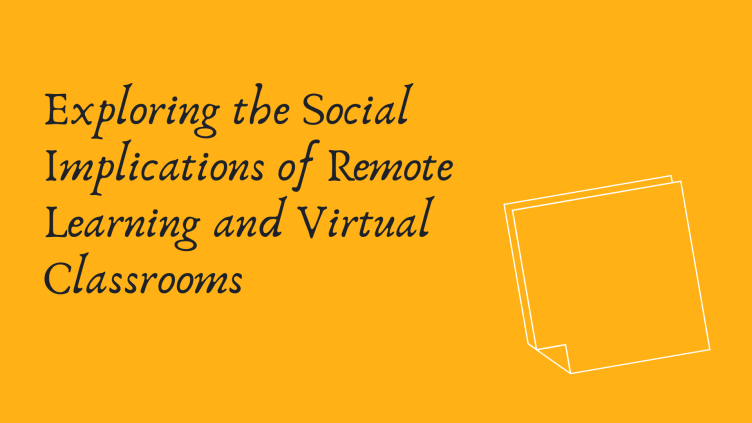In recent years, the landscape of education has undergone a profound transformation with the advent and widespread adoption of remote learning and virtual classrooms. This shift, accelerated by global events such as the COVID-19 pandemic, has not only reshaped how students access education but has also brought forth significant social implications that continue to resonate today. Let’s delve into the multifaceted impacts of remote learning on students, educators, and society at large, examining both the challenges and the opportunities it presents.
The Rise of Remote Learning: A New Educational Paradigm
Remote learning, or online education, refers to the provision of education through digital platforms and tools, allowing students to participate in classes and complete coursework from anywhere with an internet connection. Virtual classrooms simulate traditional in-person learning environments, offering lectures, assignments, discussions, and assessments in a digital format.
- Accessibility and Inclusivity
One of the most touted advantages of remote learning is its potential to democratize education. Students from diverse backgrounds and geographical locations can now access high-quality educational resources that were previously inaccessible due to distance or socioeconomic barriers. For example, students in rural areas or developing countries can attend classes from prestigious institutions around the world without needing to relocate.
- Flexibility and Personalization
Remote learning offers unparalleled flexibility, allowing students to study at their own pace and schedule. This flexibility accommodates various learning styles and preferences, empowering students to tailor their educational experience to suit their individual needs. Moreover, personalized learning technologies can adapt content delivery based on student performance and engagement levels, enhancing comprehension and retention.
- Technological Proficiency
Engaging in remote learning equips students with essential digital skills and technological proficiency that are increasingly valuable in today’s digital economy. From navigating online platforms to collaborating virtually with peers and instructors, students develop competencies that are crucial for success in a technology-driven world.
Social Challenges and Considerations
While remote learning offers numerous benefits, it also presents unique social challenges and considerations that warrant attention and exploration.
- Digital Divide and Equity Issues
Despite the promise of accessibility, the digital divide remains a significant barrier for marginalized communities. Students lacking reliable internet access or appropriate digital devices may struggle to fully participate in remote learning, exacerbating existing inequalities in educational attainment.
- Social Isolation and Psychological Well-being
The shift to virtual classrooms has raised concerns about increased social isolation among students. Human connection and peer interaction are integral to the socialization process and emotional development of young learners. Extended periods of remote learning can potentially impact students’ mental health, leading to feelings of loneliness, anxiety, and detachment.
- Pedagogical Challenges
Educators face new pedagogical challenges when transitioning from traditional teaching methods to online instruction. Maintaining student engagement, fostering meaningful interactions, and assessing learning outcomes in a virtual environment require innovative approaches and ongoing adaptation. Effective use of collaborative tools, multimedia resources, and interactive activities can enhance engagement and learning effectiveness.
The Future of Remote Learning: Adapting and Innovating
As we look to the future, remote learning is poised to continue evolving in response to emerging technologies and educational paradigms. Institutions and educators are increasingly integrating hybrid learning models that combine online and in-person instruction, offering flexibility while preserving the benefits of face-to-face interaction. Furthermore, advancements in artificial intelligence and data analytics promise to further personalize learning experiences and optimize educational outcomes.
Conclusion
The social implications of remote learning and virtual classrooms are profound and multifaceted, shaping the educational landscape in unprecedented ways. While remote learning offers expanded access, flexibility, and technological proficiency, it also presents challenges related to equity, social interaction, and pedagogical adaptation. By addressing these challenges thoughtfully and innovatively, educators and policymakers can harness the transformative potential of remote learning to create inclusive, engaging, and effective educational experiences for all students.
In conclusion, the ongoing evolution of remote learning underscores the importance of adapting educational practices to meet the needs of a rapidly changing world, emphasizing both the opportunities and the responsibilities that come with embracing digital education. As we navigate these changes, maintaining a balance between technological innovation and human connection will be crucial in shaping a future where education is accessible, equitable, and enriching for every learner.







